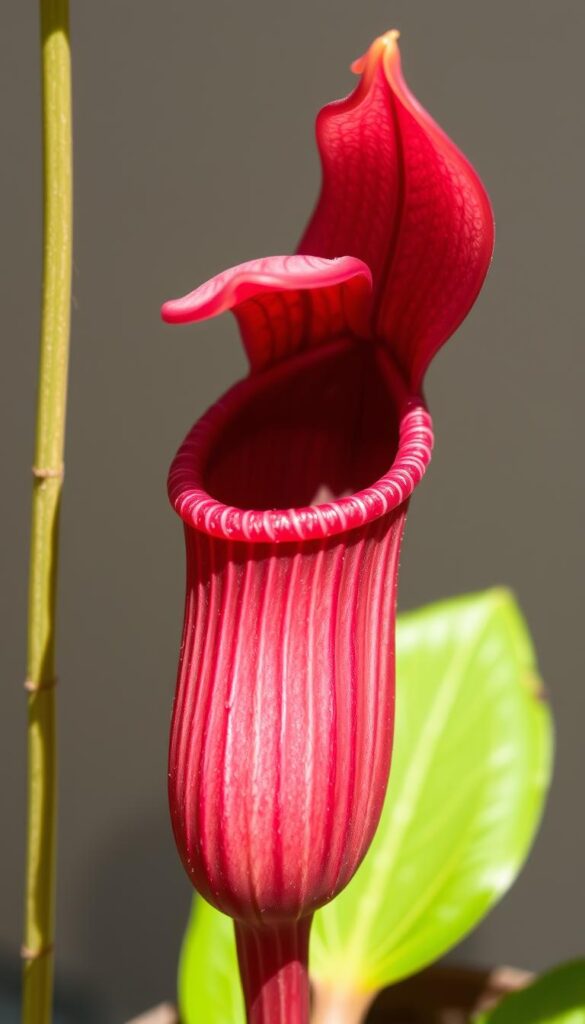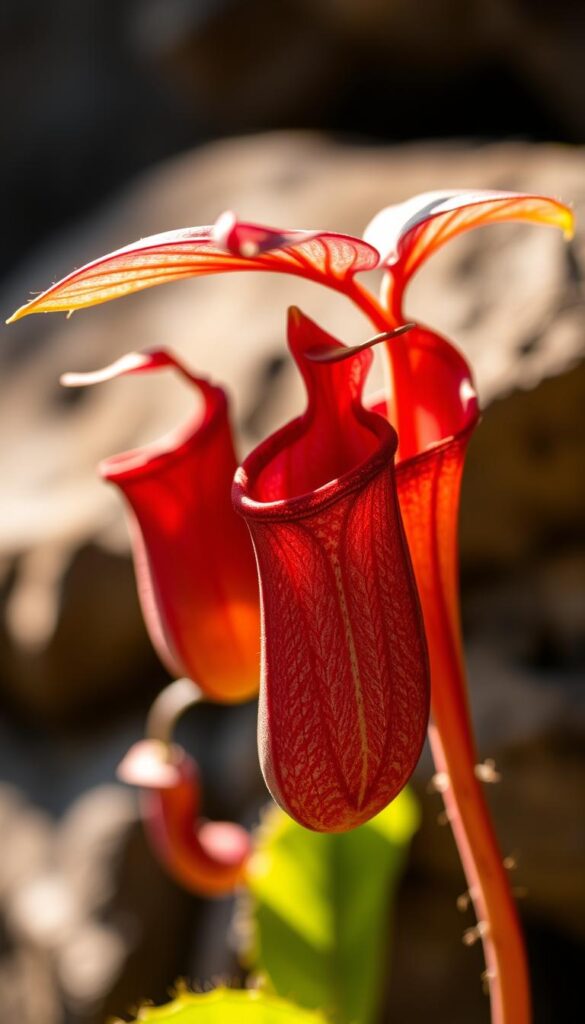There’s something undeniably captivating about the Nepenthes sanguinea, a plant that has fascinated botanists and collectors alike for centuries. Native to the lush regions of Peninsular Malaysia and southernmost Thailand, this carnivorous marvel has been a subject of intrigue since its introduction to Victorian Britain by Thomas Lobb. Its striking appearance and vibrant pitcher colors immediately draw you in, making it a standout addition to any collection.
The plant’s variable pitcher colors, ranging from green to red, add to its allure. Reaching sizes that command attention, the Nepenthes sanguinea is not just eye-catching but also historically significant. As a collector, I can attest to the deep interest this plant sparks, blending botanical marvel with practical cultivation tips that any enthusiast would appreciate.
My Personal Introduction to a Carnivorous Wonder
My journey with carnivorous plants began unexpectedly, like stumbling upon a hidden gem in a local nursery. That’s where I first laid eyes on a nepenthe, its pitcher-like traps a mesmerizing blend of form and function.
How I Discovered This Fascinating Plant
The moment I saw those vibrant pitchers, I was captivated. The unique shape and colors drew me in, sparking a curiosity I hadn’t felt before. It was as if I’d discovered something from another world, right there in the greenhouse.
First Impressions and Inspirations
Those initial impressions were powerful. The intricate details and the plant’s ability to thrive by capturing insects left me in awe. I remember thinking about how this plant had adapted to its environment, and that fascination grew into a passion.
As I delved deeper, I found joy in learning to care for my nepenthe. Watching it grow and seeing new pitchers form was incredibly rewarding. It’s a feeling that many enthusiasts share, as evident from the glowing reviews of healthy, well-shipped plants that arrive ready to thrive.
There’s something special about nurturing a plant that’s both a living sculpture and a functional marvel of nature. It’s a reminder of the beauty and complexity of the natural world, right in my own home.
Understanding nepenthes sanguinea: Origins and Characteristics
Delving into the world of Nepenthes sanguinea, it’s clear why this plant captivates so many. As a member of the Nepenthaceae family within the Plantae kingdom, it’s a true marvel of nature.
Native Habitat and Taxonomy
- Scientific Classification: Kingdom: Plantae, Family: Nepenthaceae, Genus: Nepenthes, Species: N. sanguinea.
- Natural Range: Found in Peninsular Malaysia and southern Thailand, thriving at altitudes between 300 to 1,800 meters.
- Habitat Preferences: Grows in humid, tropical regions, often as an epiphyte on trees or on rocky slopes.
Distinctive Pitcher Features
The pitchers of Nepenthes sanguinea are its most striking feature. They vary in size and color, often displaying deep red hues with intricate speckled interiors. These designs aren’t just for show; they’re evolutionary adaptations that help the plant capture insects, providing essential nutrients in nutrient-poor soil.

This unique blend of form and function makes Nepenthes sanguinea a beloved specimen among botanists and collectors, showcasing nature’s ingenuity and beauty.
Unveiling Its Stunning Visual Appeal
The visual allure of Nepenthes sanguinea is nothing short of breathtaking. This carnivorous plant captivates with its vibrant pitchers, which showcase a stunning range of colors from deep greens to rich reds.
Vibrant Colors and Intricate Speckled Patterns
One of the most striking features of Nepenthes sanguinea is the variation in pitcher colors. While some pitchers display a solid green hue, others graduate seamlessly into deep reds, creating a natural contrast that enhances their visual appeal. The intricate speckled patterns inside the pitchers add another layer of sophistication, making each one a unique piece of natural art.
- The pitchers’ vibrant and rich hues create a striking visual effect, drawing the eye and sparking curiosity.
- Intricate speckled patterns within the pitchers add to their allure, blending form and function seamlessly.
- These visual features not only attract insects but also make the plant a standout in any collection, serving both aesthetic and functional purposes.
Whether you’re a seasoned collector or a new enthusiast, the dynamic colors and patterns of Nepenthes sanguinea make it a true marvel. It’s a living piece of art that combines nature’s beauty with functional design, making it a cherished addition to any space.
Cultivation and Care: Growing My Own Pitcher Plant
Cultivating a pitcher plant is a rewarding journey that combines science with personal care. With the right techniques, even a beginner can successfully grow these fascinating plants indoors.
Ideal Light, Water, and Soil Conditions
For optimal growth, nepenthes thrive in bright, filtered light. Placing them near a sunny window with a sheer curtain works perfectly. Water is another crucial factor—using low-mineral water (50 ppm or less) ensures the plant stays healthy. The soil should be an equal mix of sphagnum moss and perlite, providing the right balance of moisture and drainage.
Tips for Windowsill and Terrarium Growth
I’ve found that a windowsill setup is ideal for nepenthes. It provides the necessary light without direct exposure. For those who prefer terrariums, maintaining high humidity and airflow is key. I’ve successfully grown my pitcher plant in a terrarium by ensuring proper ventilation to prevent mold growth.

Temperature control is vital. Daytime temperatures should be above 70°F, while nighttime temperatures can range from 55°-70°F. Avoiding frost is essential, as it can damage the plant. The gradual growth of nepenthes means they won’t overwhelm indoor spaces, making them perfect for smaller areas.
- Use bright, filtered light for optimal growth.
- Water with low-mineral water to prevent mineral buildup.
- Soil mix: Equal parts sphagnum moss and perlite.
- Maintain temperatures above 70°F during the day.
- Protect from frost to prevent damage.
Customer feedback highlights the robust nature of nepenthes when properly cared for. With these tips, you can enjoy the beauty and functionality of your pitcher plant, bringing a touch of Malaysia’s tropics into your home.
Expert Insights and Community Reviews
When it comes to growing pitcher plants like the Nepenthes sanguinea, real-life experiences from enthusiasts and experts can be incredibly valuable. Both customers and seasoned growers have shared their insights, creating a treasure trove of knowledge for anyone looking to bring this plant into their home.
What Customers and Enthusiasts Are Saying
Many customers have praised the resilience and beauty of the Nepenthes sanguinea. One enthusiast shared, “The plant arrived in perfect condition, and within weeks, I noticed new pitchers forming. It’s amazing how quickly it adapted to my terrarium setup.” Another customer highlighted the vibrant colors, saying, “The deep red hues are even more stunning than I expected. It’s a true showpiece in my collection.”
My Success Stories and Shared Experiences
Personally, I’ve found that maintaining proper humidity and providing filtered light has been key to my plant’s success. I started with a small specimen, and with consistent care, it’s grown into a robust, thriving plant. One challenge I faced was balancing the watering schedule, but once I switched to low-mineral water, the plant flourished.
Expert growers often emphasize the importance of sourcing plants from reputable sellers. They ensure that the plants are well-acclimated and properly packaged, which makes a significant difference in their health upon arrival. This aligns with customer feedback, where many have noted the healthy condition of their plants right out of the box.
Community-Backed Care Tips
The community also stresses the benefits of a well-ventilated terrarium. Proper airflow helps prevent mold and ensures the plant’s pitchers remain healthy. As one expert noted, “A common mistake is overwatering. Allowing the soil to dry slightly between waterings can prevent root rot and keep your Nepenthes thriving.”
These shared experiences highlight how, with the right care and a little patience, anyone can enjoy the beauty and functionality of a pitcher plant. Whether you’re new to carnivorous plants or a seasoned collector, the Nepenthes sanguinea offers a rewarding and visually stunning addition to your collection.
Adjusting to Environments: From Tropics to Home
Bringing a piece of Malaysia and Thailand into my home has been an exciting challenge. Acclimating a nepenthe from its tropical origins to a domestic setting requires careful attention to its needs.
Acclimation and Seasonal Adaptations
When my nepenthe arrived, I noticed the transition from a high-humidity greenhouse to my home required patience. I started by placing it in a shaded area for a week to let it adjust to the lower humidity. Gradually, I moved it to a brighter spot, ensuring it wasn’t shocked by the sudden change.
Seasonal changes also play a role. During summer, I keep the soil moist but not soggy, while in winter, I reduce watering to once a month. Maintaining temperatures above 70°F during the day and around 60°F at night has been crucial for its health.
To prevent stress, I avoid direct sunlight and use distilled water. Transitioning from a terrarium to an open pot involved increasing air circulation and monitoring humidity levels. Patience is key, as it can take months for the plant to fully adapt.
Understanding its natural habitat helps. Native to Malaysia and Thailand, this carnivorous plant thrives in humid, tropical climates. By replicating these conditions at home, I ensure it stays healthy and continues to produce vibrant pitchers.
Final Reflections on My Botanical Adventure
Reflecting on my journey with the pitcher plant, I find it incredibly rewarding to nurture such a unique species. Each pitcher it grows reminds me of the fascinating adaptability of carnivorous plants. Learning about its needs has been an ongoing adventure, blending science with personal care.
The botanical insights and care tips I’ve gathered highlight the importance of proper light, water, and soil conditions. Maintaining humidity and avoiding direct sunlight ensures its vibrant pitchers continue to thrive. It’s a delicate balance, but one that brings immense satisfaction.
What I love most about this plant is how its dynamic features and size add to its allure. Whether in a terrarium or on a windowsill, it flourishes, bringing a touch of Thailand’s tropics into my home. The blend of customer feedback and expert advice has solidified its place as a must-have carnivorous plant.
Seeing it grow in different environments fills me with joy. It’s a true marvel of nature, combining beauty with functionality. I encourage everyone to embark on their own journey with this plant, armed with practical tips and inspiration. The journey is as rewarding as the plant itself.
